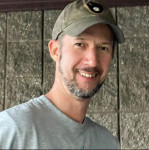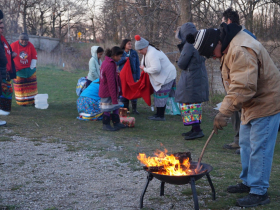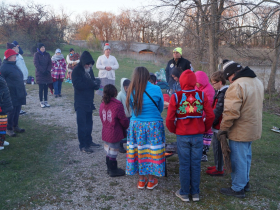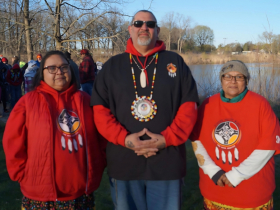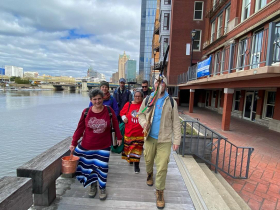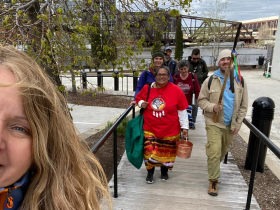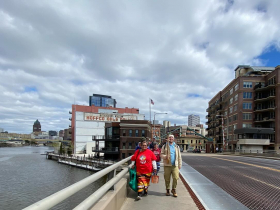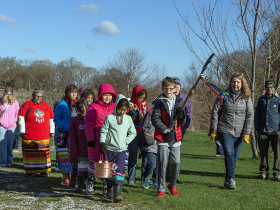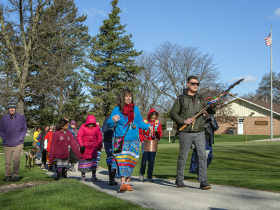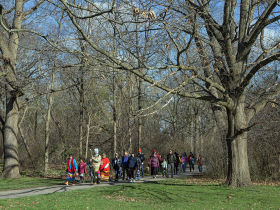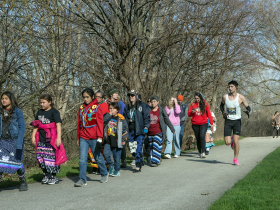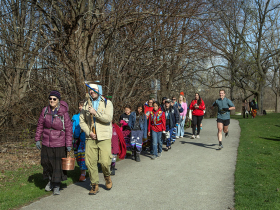Indigenous-Led Walk Honors Water
On 11-mile walk for the water, native wisdom connects environmental restoration and spiritual healing.
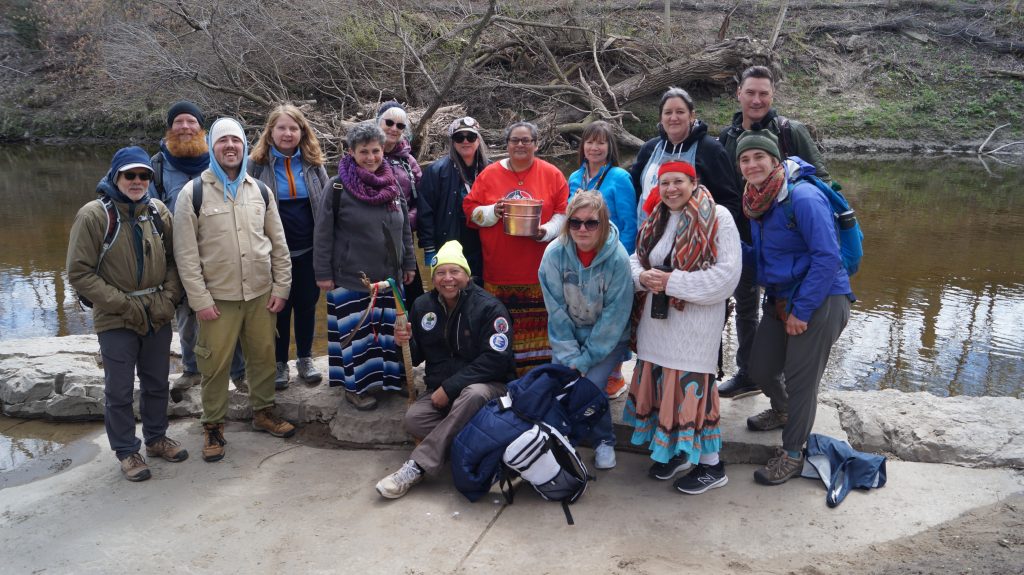
The core group poses at the Menomonee River after an 11-mile walk for the water starting along the Milwaukee River in Lincoln Park. Photo by Michael Timm.
Fire smoke and tobacco filled the predawn air. The honking of Canada geese echoed across the Milwaukee River oxbow north of Hampton Avenue as the light of sunrise sliced through gray clouds. Dozens of people, many bundled in knit caps and some wrapped in blankets, gathered at the water’s edge in Lincoln Park on Saturday, April 20, 2024 to participate in an 11-mile walk for the water.
Strong Native Minds, the Indigenous-led Milwaukee community group, sponsored the action with support of Wisconsin Native American leaders and local environmental partners.
This “Sturgeon Water Walk MKE” followed the traditional wisdom of the late Josephine Mandamin, “Grandmother Water Walker,” who led and inspired a series of water protector walks around the Great Lakes from 2003 to 2017.
In Milwaukee, walkers sought to honor and defend the water and the native lake sturgeon, now returning after decades of reintroduction efforts.
Their route transected the city, following the Milwaukee River downstream through downtown to the confluence with the Menomonee River, then west to the Urban Ecology Center at 34th Street on the bluff overlooking Three Bridges Park. Two hundred years ago, this vista would have overlooked a wild rice wetland at the heart of the Menomonee Valley occupied by Potawatomi people. In the 21st century, walkers shared trails with runners of a half-marathon and volunteers picking up trash with the annual Milwaukee Riverkeeper spring cleanup.
Walkers rallied from across Milwaukee and woke early to drive in from as far as Keshena on the Menominee Reservation. At least one person had participated in the Native American camps protesting the Dakota Access Pipeline project at Standing Rock in 2016.
Some were grandmothers. Several women wore colorful handmade ribbon skirts extending almost to the feet. “The reason for the ribbon skirt is because it brings us back to our womanhood, like our strength,” explained Maryann Galicia, board member with Strong Native Minds. “And it also connects us with Mother Earth. It’s the link within Mother Earth and the Grandmother Moon.”
The next generation took a leading role in the opening ceremony at Lincoln Park. Youth escorted a ceremonial copper water vessel for the first mile.

Children lead the procession holding the copper water vessel and eagle staff starting in Lincoln Park. Photo by Eddee Daniel.
Young girls, who had earlier practiced the rite at Indian Community School, initiated the sunrise ceremony by carrying water in individual copper cups. They shared water and strawberries with those gathered.
“Water is life. It is also medicine,” said Siobhan Marks, who guided the girls. “And it is even much more so after this ceremony.”
The girls’ voices filled the chilled air with sweet song in the Ojibwe language. Translated to English: “Water, I love you. Water, I thank you. Water, I respect you.”
“So that’s what that song is all about. And that’s what we need to do,” said Auntie Oralann Caldwell, of the Menominee Nation and Bear Clan, “to think about our lifeblood. And it’s through this water that keeps that lifeblood flowing through our beautiful, beautiful vessels that the creator put that sound of life in our spirit, in our heart, in our minds, and in our body.”
Youth offered smudge blessings of aromatic smoke and circulated with wooden bowls of dried tobacco. Participants held the tobacco in the left palm, significant for its connection to the heart, offered a prayer, then placed the tobacco into the fire, proceeding clockwise as the sun overhead. Shining red strawberries signified the heart, blood, life’s beating pulse.
The ceremony was an exercise in freedom of religion—something Native Americans were denied until the American Indian Religious Freedom Act of 1978, said Mark Denning, who helped organize the walk and led a tobacco ceremony.
Denning connected the sacred power of prayer with themes of intention, healing, family, and the environment. He shared the tragic loss of his children, and acknowledged that everyone may be facing pain, loss, or suffering.
“I’ll be thinking of her and I’ll be thinking about how she’s everywhere now,” Denning said of his daughter. “Everywhere I look, every tree that I see, that’s where she’ll be. That’s where my sons are. For those of you who have lost, that’s where your relatives are. On this walk today you’ll see them everywhere. You’ll hear them singing above your head. You’ll see the earth glow in front of you before your feet. You’re going to be touching the sacredness of our water that is so very special, and very much a part of our life.”
After the sunrise ceremony, water was blessed and poured into a brightly polished copper vessel, glinting in the sun.
A woman wearing a skirt carried the water. To her left a man carried a staff adorned with an eagle’s talon and topped with the wooden effigy of the lake sturgeon.
The pair led the procession side by side, the water never stopping once in forward motion. The woman’s ceremonial role was to protect the water, source of life, and the man’s role to protect the woman. Leaders handed off the honor of escorting the water with walkers following behind, saying, “We do this for the water.”
Several hours and eleven miles later, the women who shared the honor of carrying the water poured it into the Menomonee River, completing the journey with another tobacco blessing.
Marks watched the ripples spread as water poured from the copper vessel became one with the river, flowing on its way to Lake Michigan.
“That’s like that evident truth of that healing, right?” she said. “That beautiful water carried by all of us, starting with the beautiful fire lighting, our children singing, smudging, our tobacco ceremony, all of it, every step, every good intention, every conversation, all went to heal our water, and to protect all of our life that’s here during that dredging project, because we know there’ll be a disruption.”
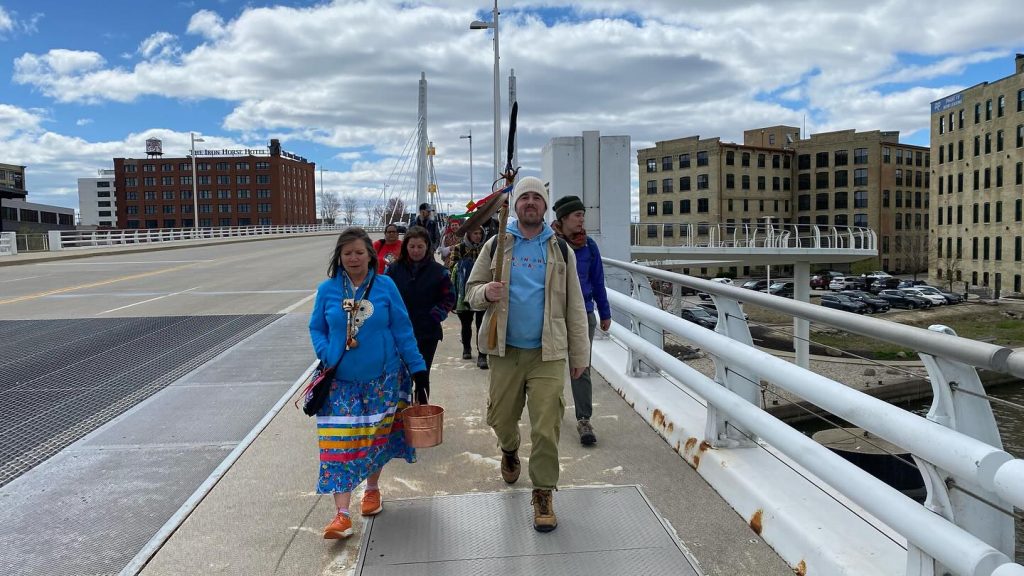
Siobhan Marks and Joe Fitzgerald lead the walkers over the 6th Street Viaduct. Photo by Cheryl Nenn.
Outside the Menomonee Valley Urban Ecology Center, walkers reunited with the all-male firekeepers from Strong Native Minds. The firekeepers’ role was to start the ceremonial fire in Lincoln Park, tend it, and safely transport it to the walk’s endpoint without letting the fire falter. The day of ceremony closed with walkers offering another blessing of tobacco into the fire.
Strong Native Minds then hosted participants upstairs at the Urban Ecology Center with a community lunch of bread and soup, where Beth Wentzel of Milwaukee Metropolitan Sewerage District shared an overview of Waterway Restoration Partnership projects to improve the habitat of the Milwaukee Estuary Area of Concern.
Wentzel highlighted fish passage projects designed to benefit self-sustaining populations of lake sturgeon. This included the Kletzsch Dam fishway, previously reported by Urban Milwaukee, and plans to modify Estabrook Falls near the biergarten to make it easier for native fish to make it upstream. This project could start as early as summer 2025.
Native Americans have endured generations of forced removals, assimilation, cultural traumas, and freedoms denied, so Denning said projects like these to benefit native species have the potential to help restore a sense of Native identity.
Denning is a member of Sturgeon Clan, and the heart of the volunteer group Sturgeon Protectors, organized to educate the public about lake sturgeon. Eleven sturgeon have been detected so far this spring by an underwater array in the Milwaukee River near Urban Ecology Center Riverside. As animal species return to Wisconsin waters—including otters, pelicans, beavers, sturgeon—Denning said those Anishinaabe Clans whose identities are rooted in these animal spirits are reinvigorated.
Their enduring presence is recognized as part of a larger whole.
Caldwell, whose Native name means “Yellow Thunder Cloud Woman,” offered a lesson in water’s central role as source of spiritual life force in an Indigenous creation story. The honored storyteller invited contemplation of “the beginning before the beginning.”
Marks then described how anyone may assemble “water bundles” of natural items that can be offered seasonally to honor the water.
The walk was an opportunity to build new community bonds and strengthen a sense of common humanity, especially among Milwaukee’s Indigenous community.
Ron Grieger, Jr. founded Strong Native Minds in 2021 with his wife Winona.
“I feel like we’ve lost a lot of our connection,” he said. “We lost a lot of our insight in who we are as Native people, how we live and how we take care of each other. If we lose those stories or we lose those connections, we’re going to lose everything about ourselves.”
The group exists to counteract that cultural drift.
Welcoming all people, Strong Native Minds hosts men’s talking circles and cultural arts where women learn how to bead, embroider, and make ribbon skirts together. They sponsored de-escalation training for Sturgeon Protectors volunteers and also connect youth with elders to cut lawns and clean attics.
“The more that we communicate amongst each other, that just enhances us and embraces us even more and makes us stronger,” Grieger said. “And that’s the whole purpose of this.”
Photo Gallery by Michael Timm
Photo Gallery by Cheryl Nenn
Photo Gallery by Eddee Daniel
Story by Michael Timm, a Milwaukee Water Storyteller for the nonprofit Reflo, who did our earlier series on reintroducing the sturgeon into the Milwaukee River.
This project is funded by the Wisconsin Department of Administration, Wisconsin Coastal Management Program and the National Oceanic and Atmospheric Administration under the terms and conditions of Wisconsin Coastal Management Program Grant Agreement No. AD239125-024.21. Funded by the Wisconsin Coastal Management Program and the National Oceanic and Atmospheric Administration, Office for Coastal Management under the Coastal Zone Management Act, Grant # NA22NOS4190085

